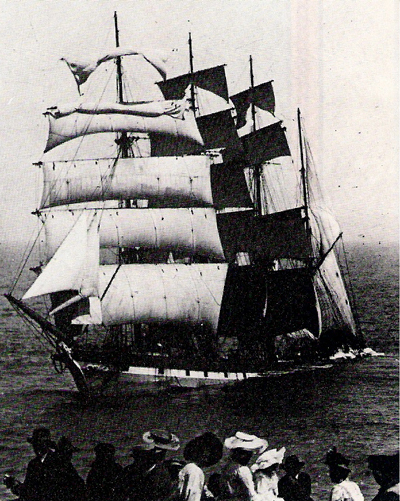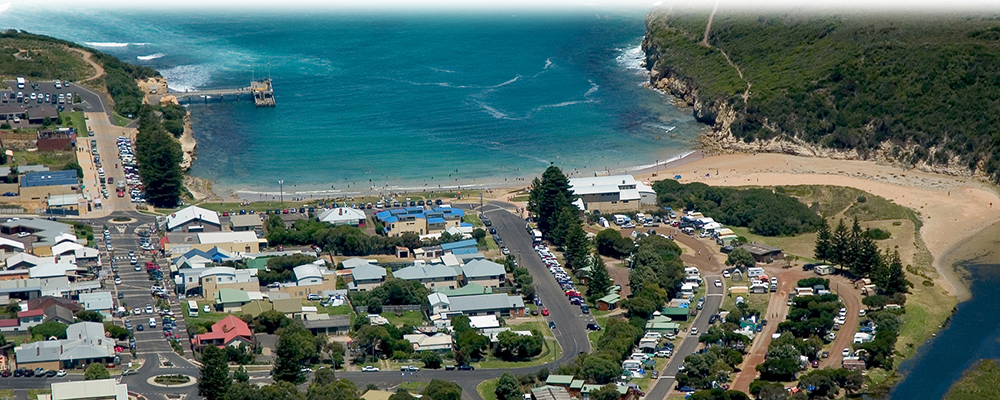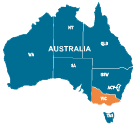Port Campbell National Park
London Bridge
The Grotto
Bay Of Islands
Loch Ard Gorge
The 12 Apostles
Gibson's Steps
Port Campbell Attractions
Shipwrecks around Port Campbell National Park
 Falls of Halladale |
The west coast of Victoria once inspired fear, sailors spoke of wild seas and dangerous rocks, of reefs which lay beneath the surface of the water, of steep cliffs and heavy mists.
Many ships had narrow escapes in this stretch of water, many were not so fortunate. The area between Cape Otway and Port Fairy claimed over 80 ships in 40 years: ships which had traveled safely across half the world, to find disaster only miles from there destination.
Some of the more documented wrecks:-
Children: 3 mastered barque built in Liverpool in 1825, wrecked near Childers Cove on the 15th January 1839 In poor weather, struck a reef close to a small inlet in the sheer cliffs. Children left Launceston for Adelaide on 11 January with 24 passengers including 9 children, 14 crew and a mixed cargo including livestock. As the ship disintegrated those still alive were forced to the forecastle, only to be washed off one by one. Within two hours the wreck had disappeared. Those drowned included the Captain, six men, a lady passenger and four of her children; four other children also drowned.
Falls of Halladale: was a 2085 tonne Barque built in Glascow in 1886. She was carrying cargo from New York to Melbourne when she struck a reef west of Peterborough on the 14th November 1908. It was reported that the captain lost his bearings due to heavy mist.
The ship remained on the reef with all sails set for 2 months. All on board survived.
Schomberg: Was one of the most magnificent sailing ships ever built, was wrecked at Curdies Inlet near Peterborough on the 27th December 1855. It was reported that Captain Forbes was below deck entertaining a female passenger when the vessel drove ashore. His career was wrecked as well as the ship.
Young Australia: 3 Masted 130 tonne Wood Schooner wrecked at Curdies Inlet near Peterborough on the 28th May 1877. Was sailing from Maryborough, Queensland to Adelaide with a cargo of rum and sugar; when she was caught in rough weather which carried away her rigging, causing the fore top mast to fall, springing the foremast. One of the crew endeavoured to reach the shore with a line, but was drowned.
Newfield: left Brisbane with a cargo of rock salt in 1892. The Captain mistook the Cape Otway light for the one on Cape Wickham, King Island, and in altering his course ran onto a reef east of Peterborough on the 29th August 1892. Nine crew members were drowned.
Napier: wrecked near Port Campbell in July 1878
Loch Ard: at approximately 5 o’clock on the morning of June 1st 1878 the clipper Loch Ard was approaching the western entrance to Bass Strait, when in thick mist she ran onto a reef at Mutton Bird Island, near Port Campbell. Out of 51 people on board only 2 survived Thomas Pearce and Eva Carmichael both 18 years.Thomas was an apprentice on the ship who later went on to captain steam ships. Eva later returned to Ireland. Another survivor was the now priceless minton statue “The Loch Ard Peacock” which is on display at Warrnambool’s Maritime Museum along with other artifacts from the wreck.
Fuji: 3 Masted Barque built in Belfast in 1875. On a voyage from Hamburg Germany to Melbourne with a crew of 20 and general cargo including 200 cases of dynamite was wrecked at Moonlight Head on the 6th September 1891 (only a short distance west of where the Marie Gabrielle was wrecked in 1864) Several crew made it to shore, but 12 lives were lost.
The continuous heavy seas which roll in onto Wreck Beach prevented organised salvage attempts but in 1894 several divers managed to salvage some of the hundreds of tons of coiled wire rope which had formed part of her cargo
Marie Gabrielle: 3 Masted 258 tonne French Barque built in 1864. Was bound for Melbourne with a cargo of tea when she got caught in a gale and ran ashore at Wreck Beach near Moonlight Head on the 24th November 1869. Fortunately all on board survived. The hull split in two from stem to stern, the keel having disappeared, and the bow lying between two large rocks. The figurehead was lying on the beach and hundreds of chests of tea were floating in the surf.
A principal salvor of the cargo was Hugh Gibson from Glenample Homestead, later to be involved in the rescue of Eva Carmichael from the wrecked Loch Ard in 1878. Anchors from the Marie Gabrielle can be seen embedded in the rocky shore, west of Moonlight Head.
Antares (1888-1914): Was the last sailing ship wrecked along this stretch of coastline. On a voyage from Marseilles to Melbourne during the first world war, the vessel sank with the los of all hands.
Shipwrecks around Warrnambool
There are 15 shipwrecks in Lady Bay, dating from 1850 to 1905.
Mahogany Ship: In the 1800's there were several sightings of an 'ancient wreck' in the dunes between Port Fairy and Warrnambool. Theories about its identity vary from a Portuguese caravel to a convict escape craft. The mysterious ship has to date not been located despite many extensive searches.
Shipwrecks around Port Fairy
Some 20 ships were lost to gales in the Port Fairy area dating from 1836 to 1876





